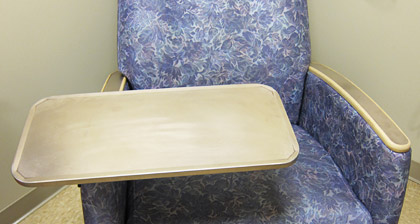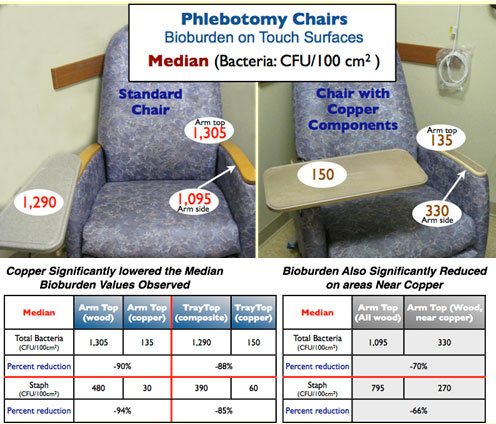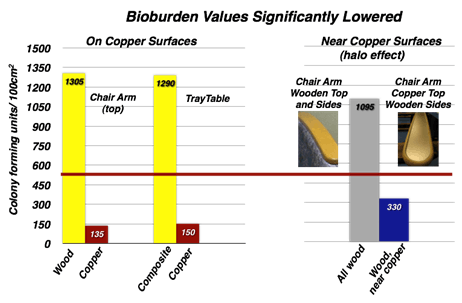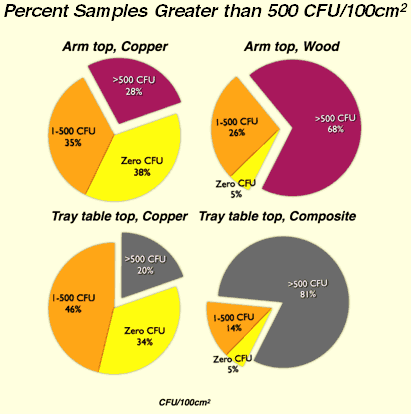Related Trials
The following results are from an independent clinical trial and are not part of the research supported by the U.S. Army Medical Research and Materiel Command under Contract No. W81XWH-07-C-0053.
Copper Surfaces Reduce the Microbial Burden in an Out-Patient Infectious Disease Clinic
Independent clinical studies assessed the microbial burden on the touch surfaces of phlebotomy chairs and trays at the Division of Infectious Diseases in North Shore University Hospital, in Manhasset, NY. The wooden arms and plastic tray tables on two of the three phlebotomy chairs used in the study were fitted with a copper alloy (90% copper/10% nickel) arm inlay, while the sides of the chair arms were unchanged. The trays were fabricated entirely from this copper alloy.
 Phlebotomy chair with full copper alloy tray and copper alloy inlay on wooden chair arm
Phlebotomy chair with full copper alloy tray and copper alloy inlay on wooden chair armAll sampling methodology and statistical analysis was undertaken by the Medical University of South Carolina and the trial was sponsored by the Copper Development Association Inc., New York, NY.
The testing protocols are described in detail in the research poster presented at the 2010 Interscience Conference on Antimicrobial Agents in Chemotherapay (ICAAC) in Boston, MA.
Download research poster "Copper Surfaces Reduce the Microbial Burden in an Out-Patient Infectious Disease Practice" [complete PDF - 1.3 Mb]

The copper alloy surfaces significantly lowered the microbial burden found on the tray and copper inlay chair arms, as is shown in the table above. The median bioload cultured from the tray tables demonstrated an 88% reduction of bacteria on copper compared to non-copper. On the chair arms with the copper alloys, a 90% bioload reduction was observed. The majority of the microorganisms identified were Staphylococci. MRSA and VRE were not recovered during the study.
The majority of the samples from the chairs with copper alloy inlays were below the level thought to represent a risk to the patient (500CFU/100cm2, Dancer 2004), while the majority of samples from the non-copper chairs were above this line (red line in the graph below).

The microbiocidal properties of copper and its alloys were shown to confer an "antimicrobial halo effect" within the general facility of the arm top, as indicated in the bioburden graph above. The microbial burden on the wooden portion of the chair arm adjacent to the inlaid copper alloy was significantly lower, by 70%, than the control.

The pie graphs summarize the continuous microbiocidal activity of copper after 3 weeks of a proposed 9 week study and show an almost inverse relationship between the percentage of samples collected with more than 500 CFU/100cm2 (the level believed to present a significant risk to patients) on copper versus the control. On the copper arm top, approximately 73% of the samples had less than 500 CFU/100cm2. Of these, 35% had between 1 and 500 CFU/100cm2, while 38% had zero CFUs. Approximately 28% of the samples had more than 500 CFU/100cm2. On the wood arm top, approximately 68% of the samples contained more than 500 CFU/100cm2, while only 31% contained either zero or 1 to 500 CFU/100cm2.
The results were similar on the copper alloy tray vs. the control. 80% of the samples had less than 500 CFU/100cm2. Of these, 34% had zero CFU/100cm2 and 46% had from 1 to 500 CFU/100cm2. On the control tray, 81% of samples had more than 500 CFU/100cm2, while only 15% of samples had either less than 1 to 500 or zero CFU/100cm2.
A total of 446 patients used the study chairs, of which 2/3 were HIV positive.
The chairs were wiped down at the end of each working day with a cleanser wipe (PDI Sanicloth Germicidal Disposal wipes™). This is the standard cleaning schedule in this facility, no changes were made to accommodate this study. All environmental samples were collected by a single individual (RN).
A manuscript with the final results is currently in development. For further information about this study, please contact Wilton Moran.
For further information about Antimicrobial Copper, please visit AntimicrbialCopper.com.